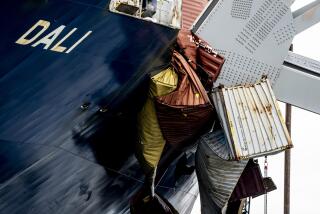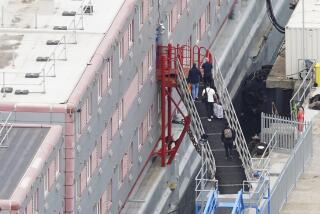CANADA : Activists Get Sinking Feeling as Raising of Oil Barge Nears
- Share via
CHARLOTTETOWN, Canada — Ocean salvage experts from Canada, the United States and Europe are assembled at this Atlantic seaport for a delicate and controversial effort to raise an oil-laden barge from the depths of the Gulf of St. Lawrence, where it sank 26 years ago.
The barge has been slowly leaking its cargo of bunker oil as well as heating fluid laced with hazardous PCBs since it was swamped in a storm and settled 220 feet below the surface. Raising the vessel would remove the pollution source, but it also carries a risk that the barge could break up, resulting in a catastrophic spill.
Exactly how great a risk is a matter of contention. The government argues that lifting the barge is much safer--and less costly--than pumping the oil out of the vessel while it sits on the sea bottom or doing nothing while the wreck continues to deteriorate.
“It’s not a no-risk situation, but we want to keep risks to a minimum,” said Bill Dancer, who commands the operation from the bridge of a Canadian Coast Guard icebreaker stationed above the wreck.
John Noble, a British expert who is here as an independent observer, brushed aside concerns of a leak. “I don’t anticipate any spilling of oil,” he said. “In salvage and wreck-removal terms, this is really a very simple and straightforward operation.”
Such assurances have satisfied some environmentalists, but not all.
“There is going to be a major slick with this operation. There will be an uncontrollable release of oil and possibly of PCBs,” activist Daniel Green predicted to reporters earlier in the week. Green’s organization, the Montreal-based Society to Vanquish Pollution, has unsuccessfully fought a court battle to halt the recovery.
A large spill could cost Canada’s east coast fishing and tourism industries nearly $300 million, the Coast Guard calculates, and would affect countless seabirds, fish and dolphins. The area also is near the feeding grounds of several whale species.
The confidence with which the government approaches the task is testament to the advances in diving, salvage and oil containment over the last decade. But for the last year, this operation has been plagued by bad weather, bad publicity and bad luck. So far, the only thing that has risen is the cost to Canadian taxpayers, which now stands at more than $22 million, three times the original estimate.
The current timetable calls for lifting the barge toward the end of this month. But to complete the operation, the salvage team needs at least 48 consecutive hours of calm seas, and this has been a blustery summer, said Coast Guard spokesman Dick Pepper.
“We’ve had six gales now,” said Pepper, adding that they blew in during what is normally the best weather window for this part of the Atlantic.
The latest setback was Hurricane Bertha. While the deadly storm had lost most of its power by the time it reached Canada, it nonetheless forced the fleet of salvage ships into port and delayed the arrival of additional vessels from the United States.
The barge, the Irving Whale owned by Irving Oil Co. of St. John, Canada, sank about 40 miles north of the Canadian province of Prince Edward Island with 4,200 tons of oil and 7.5 tons of PCB heating fluid on board. Officials believe 3,100 tons of oil remain and that leakage of the PCBs has been minimal. Inspections by the salvagers’ dive team indicate that only about 5% of the hull has been lost to corrosion.
Irving Oil no longer claims ownership of the barge, and although the company is providing support services for the recovery team, the vast bulk of the cost is falling on the government.
More to Read
Sign up for Essential California
The most important California stories and recommendations in your inbox every morning.
You may occasionally receive promotional content from the Los Angeles Times.













